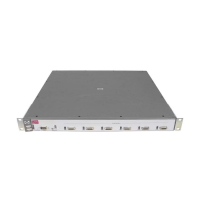IP Routing Features
Configuring IP Parameters for Routing Switches
Enabling Proxy ARP
Proxy ARP allows a routing switch to answer ARP requests from devices on
one network on behalf of devices in another network. Since ARP requests are
MAC-layer broadcasts, they reach only the devices that are directly connected
to the sender of the ARP request. Thus, ARP requests do not cross routers.
For example, if Proxy ARP is enabled on a routing switch connected to two
sub-nets, 10.10.10.0/24 and 20.20.20.0/24, the routing switch can respond to an
ARP request from 10.10.10.69 for the MAC address of the device with IP
address 20.20.20.69. In standard ARP, a request from a device in the 10.10.10.0/
24 sub-net cannot reach a device in the 20.20.20.0 sub-net if the sub-nets are
on different network cables, and thus is not answered.
An ARP request from one sub-net can reach another sub-net when both sub-
nets are on the same physical segment (Ethernet cable), since MAC-layer
broadcasts reach all the devices on the segment.
Proxy ARP is disabled by default on HP routing switches. To enable Proxy
ARP, enter the following commands from the VLAN context level in the CLI:
HPswitch(config)# vlan 1
HPswitch(vlan-1)# ip proxy-arp
To again disable IP proxy ARP, enter the following command:
HPswitch(vlan-1)# no ip proxy-arp
Syntax: [no] ip proxy-arp
Configuring Forwarding Parameters
The following configurable parameters control the forwarding behavior of HP
routing switches:
■ Time-To-Live (TTL) threshold
■ Forwarding of directed broadcasts
All these parameters are global and thus affect all IP interfaces configured on
the routing switch.
To configure these parameters, use the procedures in the following sections.
11-13

